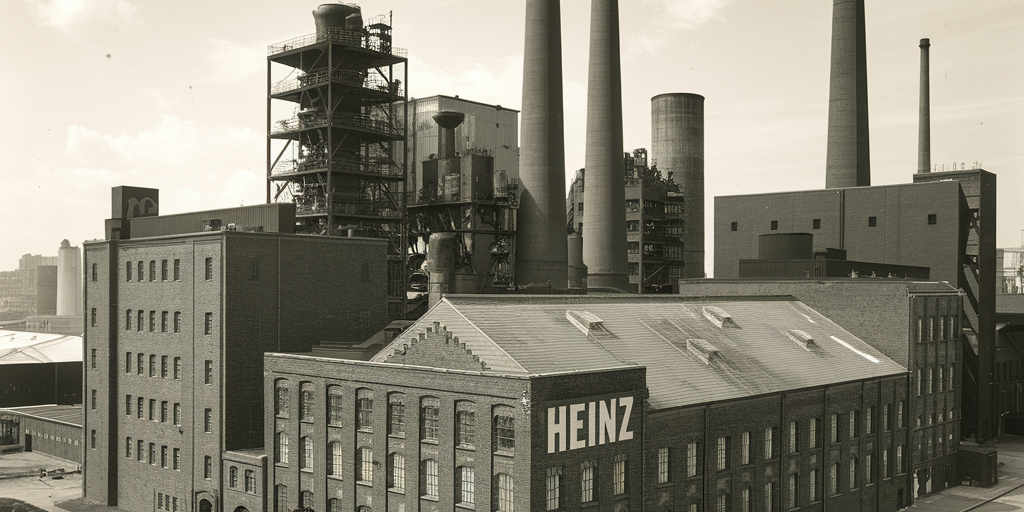A Pittsburgh Icon That Became a Global Brand
Discover the fascinating history of Heinz Ketchup, born in Pittsburgh and now a global icon. Learn how Henry Heinzbuilt a ketchup empire that changed the food industry forever.
The Humble Beginnings: A Boy and His Garden
Henry J. Heinz was born in 1844 in the Birmingham section of Pittsburgh (now the South Side) to German immigrant parents. By the age of 8, young Henry was already bottling horseradish cultivated from his mother’s garden and selling it to neighbors. Unlike the typical cheap product of the day, Henry packed his horseradish in clear glass bottles—a decision that set the tone for his business philosophy: transparency, quality, and trust.
In an era when many food products were murky, adulterated, or downright unsafe, Heinz’s clear glass packaging was a revelation. It was a subtle but powerful way of saying, “I have nothing to hide.”
From Bankruptcy to the Birth of a Brand
By 1869, Henry launched H. J. Heinz & Co. with friend L. Clarence Noble, starting with bottled horseradish. But like many 19th-century businesses, the company was hit hard by the Panic of 1873, leading to bankruptcy.
Not one to give up, Heinz regrouped in 1876, founded F. & J. Heinz with his brother and cousin, and introduced what would become his flagship product: tomato ketchup.
Interestingly, ketchup at the time was prone to spoilage and contamination—made worse by questionable preservation methods. Heinz tackled this head-on, championing cleanliness, proper sterilization, and quality ingredients. By doing so, he made ketchup not just a condiment but a trusted household staple.
The Magic of “57 Varieties”
Ask anyone what “57 Varieties” means, and you’ll hear plenty of guesses. But here’s the truth: It was a brilliant marketing ploy—and a complete fabrication.
By 1896, Heinz already produced over 60 products. While riding an elevated train in New York, Henry saw an ad for “21 styles of shoes” and thought, “I need something catchy like that.” He settled on 57 simply because he liked the number.
The slogan stuck. Today, “57 Varieties” is stamped on every Heinz ketchup bottle—not because it’s accurate, but because it’s memorable.
Pioneering Food Safety Before It Was Cool
Decades before the Pure Food and Drug Act of 1906, Henry Heinz made food safety his company’s mission. He allowed tours of his state-of-the-art factories, showcasing sanitary conditions and fresh ingredients to skeptical customers.
Heinz understood that trust was the real product he was selling. Ketchup—made with ripe tomatoes, distilled vinegar, and spices—became a symbol of quality in a time when many food companies cut corners.
This commitment to safety and transparency helped Heinz emerge as a gold standard in the food industry.
Pittsburgh Roots, Global Reach
Throughout the late 19th and early 20th centuries, Heinz grew into a Pittsburgh powerhouse. By the time of Henry’s death in 1919, the company employed thousands in the city and operated factories across the U.S. and internationally.
The iconic Heinz plant on Pittsburgh’s North Side became a landmark, producing everything from pickles to baked beans to that famous ketchup. As railroads and shipping expanded, so did Heinz’s reach—eventually becoming a global brand sold in over 200 countries.
Why Heinz Ketchup Tastes So Good
Heinz ketchup’s enduring success isn’t just marketing—it’s science. The recipe, perfected in the early 1900s, balances sweet, salty, sour, bitter, and umami—hitting all five basic tastes. That perfect blend is why Heinz ketchup pairs so effortlessly with everything from burgers to fries.
Even today, competitors struggle to replicate the exact taste. Food scientists often cite Heinz as the gold standard of ketchup flavor—a recipe nearly impossible to improve.
The Brand That Defined a Category
By the mid-20th century, Heinz wasn’t just a ketchup company—it was the ketchup company. Its products became so embedded in American culture that asking for ketchup was often synonymous with asking for Heinz.
Along the way, Heinz innovated in packaging too—introducing the squeeze bottle in the 1980s, making it easier for customers to get that last drop.
Today, Heinz is owned by the Kraft Heinz Company, one of the largest food companies in the world, but its Pittsburgh legacy is undeniable.
Legacy: More Than a Condiment
Henry Heinz’s vision was simple: “To do a common thing uncommonly well.” That philosophy turned his small family business into a global empire.
From its transparent beginnings to worldwide dominance, Heinz’s story is a classic tale of American ingenuity, marketing genius, and unwavering commitment to quality. More than just a condiment, Heinz ketchup is a piece of Pittsburgh’s history—and a staple on tables around the world.
So, next time you tap the bottom of that glass bottle, remember—you’re holding a piece of Pittsburgh’s legacy.
Frequently Asked Questions (FAQs)
Q: Who invented Heinz Ketchup?
A: Henry J. Heinz, a Pittsburgh entrepreneur, introduced Heinz Tomato Ketchup in 1876, revolutionizing the condiment with a focus on quality and food safety.
Q: What does “57 Varieties” mean on Heinz bottles?
A: It was a marketing slogan created by Henry Heinz in 1896. The number 57 was chosen for its catchy appeal, not because of the actual number of products.
Q: Why is Heinz considered the best ketchup?
A: Heinz’s recipe balances sweet, salty, sour, bitter, and umami flavors, making it taste better and pair perfectly with food. It also set industry standards for safety and quality.
Q: Is Heinz still connected to Pittsburgh?
A: Yes! Heinz was founded in Pittsburgh, and the company’s roots and legacy remain a major part of the city’s industrial and cultural history.









